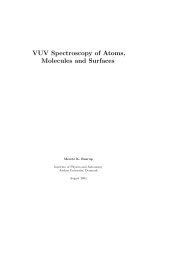Paramount GT-1100 Robotic Telescope Mount
Paramount GT-1100 Robotic Telescope Mount
Paramount GT-1100 Robotic Telescope Mount
You also want an ePaper? Increase the reach of your titles
YUMPU automatically turns print PDFs into web optimized ePapers that Google loves.
<strong>Paramount</strong> User’s Guide page 33<br />
Figure 21 – Remove these four screws to access the azimuth nosepiece. (View of<br />
bottom of the mount.)<br />
Next, remove the four hex screws that hold the nosepiece in place. You'll see the additional<br />
sets of mounting holes beneath this piece. Remount the nosepiece in the holes that give you<br />
the desired azimuth adjustment.<br />
<strong>Paramount</strong> ME Quick Polar Alignment Method<br />
The <strong>Paramount</strong> ME contains homing sensors that can be used aid in the first step in polar<br />
alignment. Each time the <strong>Paramount</strong> ME is homed, it returns to the exact same position (i.e.<br />
to an encoder tic, or a fraction of an arcsecond). This position is very near hour angle 2.0<br />
and declination 0.0. This is a point two hours west of the Meridian on the celestial equator.<br />
Though the mount does home to the exact same position each time, it is not precisely at<br />
hour angle 2.0000 and declination 0.0000. This is in part due to consistency of the position<br />
of the emitter-detector pair in the sensors used. Additionally, if the main optic of the system<br />
is used for star sighting, it will have inherent non-perpendicularity errors. Therefore, the<br />
following procedure can be deemed “very good” as far as estimating polar alignment, but the<br />
full procedure using TPoint will refine the alignment to the desired level of accuracy.<br />
However, if you are consistent in attaching your OTA to the ME, you will find that this<br />
procedure will be very accurate each time the ME is set up. When the star-sync is performed,<br />
it represents a calibration of many of the errors.<br />
Step 1 – Level the mount, and set the altitude and azimuth as close as possible.<br />
A level mount is not required for extremely precise operation, but it is necessary for the<br />
purposes of the following alignment procedure. Using the gradations on the side of the<br />
wedge assembly, estimate the altitude based on the latitude of the observing site.<br />
Step 2 – Home mount with the proper date/time information in TheSky.<br />
By homing the mount from TheSky software with the proper time and date information, the<br />
Local Sidereal Time (LST) will be computed and therefore the position of the telescope, if it<br />
were aligned properly with the pole, is known to within ± 10 arcminutes.















